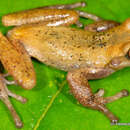Description
provided by AmphibiaWeb articles
Gastrotheca antoniiochoai is a small species of Gastrotheca, with an average male SVL of 26.5 mm (from two specimens) and female SVL of 32.5 mm (in a single specimen). Diagnostic characteristics include the following: Skin on dorsum is smooth to finely rugose and lacks transverse ridges. The interorbital distance is about 1.36x the width of the eye. The tympanic annulus is smooth. Supraciliary processes are absent. Finger I is shorter than finger II. Fingers are unwebbed and terminate in expanded discs, which range from 1.1x (Finger I) to 1.6x (Fingers III, IV) digit width. Toes are basally webbed between Toe III and V. Neither calcar nor tubercles are present on the heel. The shank (tibial length) is 51.6% of SVL and 108.5% of foot length. Females have paired, lateral brood pouches, as discussed in the following paragraph. In addition to the preceding diagnostic characters, the iris is bronze, and males have well-developed, tan nuptial excrescences (Catenazzi and Lehr 2009).Like other members of the genus Gastrotheca, female G. antoniiochoai bear a closed brood pouch. However, the brood pouch morphology is unusual; this species has a lateral, paired brood pouch, unlike most members of the genus Gastrotheca, in which females have a single dorsomedian brood pouch. Only three other Gastrotheca species with paired brood pouches are known: G. zeugocystis, from central Peru, plus G. walkeri and G. williamsonii, both from Venezuela (Catenazzi and Lehr 2009).Dorsal coloration is brown to golden tan. Tiny darker spots and green spots are scattered dorsally from the interorbital region to the sacral area. Eyelids have narrow dark flecking along their length. A tan stripe runs laterally from the nostrils to the posterior margin of the cilia (on the eyes). No interorbital or T-shaped dorsal markings are present. No pale dorsolateral stripe is present. Flanks are beige with tiny dark brown spots. Venter is gray-brown or beige with many black melanophores. Juvenile coloration differs somewhat from that of the adult. In juveniles, the limbs are barred. Also, in juveniles the dark tan band runs from the nares laterally all the way to the midbody, but with an interruption above the arm insertion. Further, juveniles have reddish-bronze irises with black reticulations, rather than bronze irises (Catenazzi and Lehr 2009).This frog was formerly thought to be a member of the genus Hyla, but the original description (De la Riva and Chaparro 2005) was based on a subadult female and a juvenile, according to Catenazzi and Lehr (2009).G. antoniiochoai may be related to G. zeugocystis, since both have the unusual characteristic of lateral paired brood pouches in females, are similar in general appearance in coloration, occur in cloudforests and take refuge in bromeliads. However, the type localities for these two species are separated by over 600 km and by the valley of the Río Apurimac, which has been proposed as a biogeographic barrier for other clades of frogs (Catenazzi and Lehr 2009).
Catenazzi, A., and Lehr, E. (2009). ''The generic allocation of “Hyla” antoniiochoai De la Riva & Chaparro, 2005 (Anura), with description of its advertisement call and ecology.'' Zootaxa, 2304, 61-68.
Distribution and Habitat
provided by AmphibiaWeb articles
Occurs in southeastern Peru, in Manu National Park, on the eastern slopes of the Andes. The type locality is near Quebrada Toqoryuoc, Wayqecha Research Center, Kosñipata Valley, Región Cusco, Peru. This species is found in cloudforest and montane scrub at 2,700-3,300 m asl. Gastrotheca antoniiochoai inhabits epiphytic bromeliads, six to eight feet above the ground (Catenazzi and Lehr 2009).
Life History, Abundance, Activity, and Special Behaviors
provided by AmphibiaWeb articles
The call consists of a long note followed by one, two, or three pulsed, short secondary notes, with an average call frequency of 32.2 calls/minute (range 18-40 calls/minute). The median dominant frequency of the long note was 2915 Hz (range 2544-2968 Hz), while the median dominant frequency of the short notes was 3286 Hz (range 1749-3445 Hz) (Catenazzi and Lehr 2009).This species is thought to be direct-developing, based on the size and number of eggs (Catenazzi and Lehr 2009), plus the fact that in other cloudforest Gastrotheca species, the embryos develop into froglets within the dorsal pouch (Duellman and Maness 1980; Wassersug and Duellman 1984). A female specimen had a total of six relatively large eggs within her lateral, paired brood pouches, with each egg measuring about 6.5 mm in diameter. Although the female was kept in captivity for some time, the eggs slipped out of the pouch and did not complete development, so it was not possible to directly observe whether a larval stage ensued (Catenazzi and Lehr 2009).
Life History, Abundance, Activity, and Special Behaviors
provided by AmphibiaWeb articles
This species is currently considered Data Deficient and thus nothing is known about the population status.
Gastrotheca antoniiochoai: Brief Summary
provided by wikipedia EN
Gastrotheca antoniiochoai is a species of frog in the family Hemiphractidae. It is endemic to Peru and only known from near its type locality near the Wayqecha Biological Station (Cusco Region). It has been collected from cloud forest at elevations of about 2,817–2,845 m (9,242–9,334 ft) above sea level. It appears to be an arboreal species living in bromeliads. The species occurs in the Manú National Park and does not face significant threats.
- license
- cc-by-sa-3.0
- copyright
- Wikipedia authors and editors

